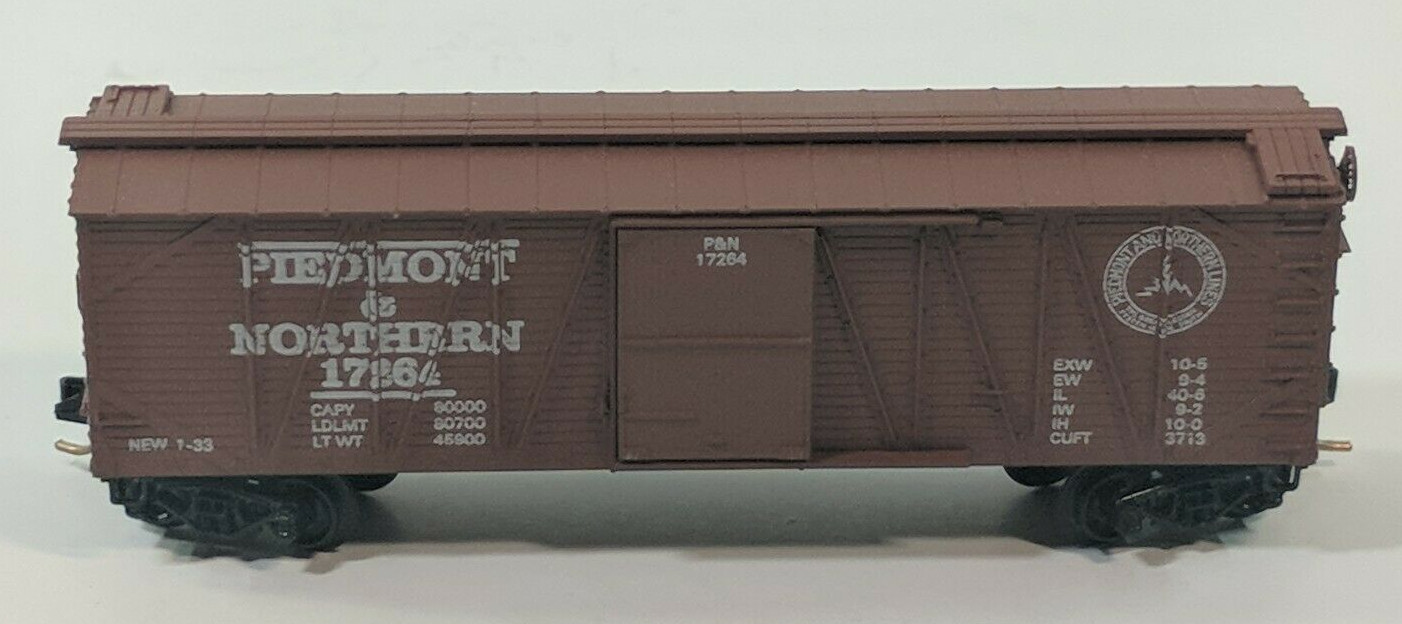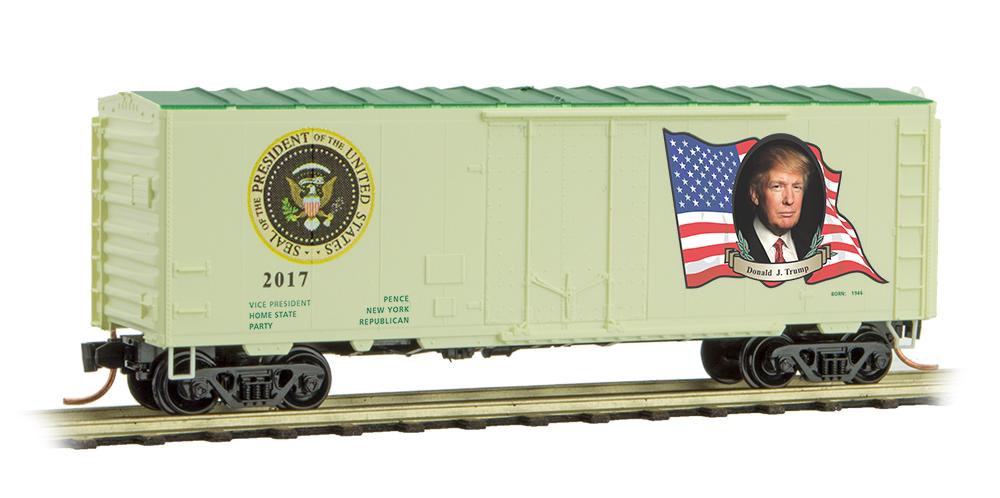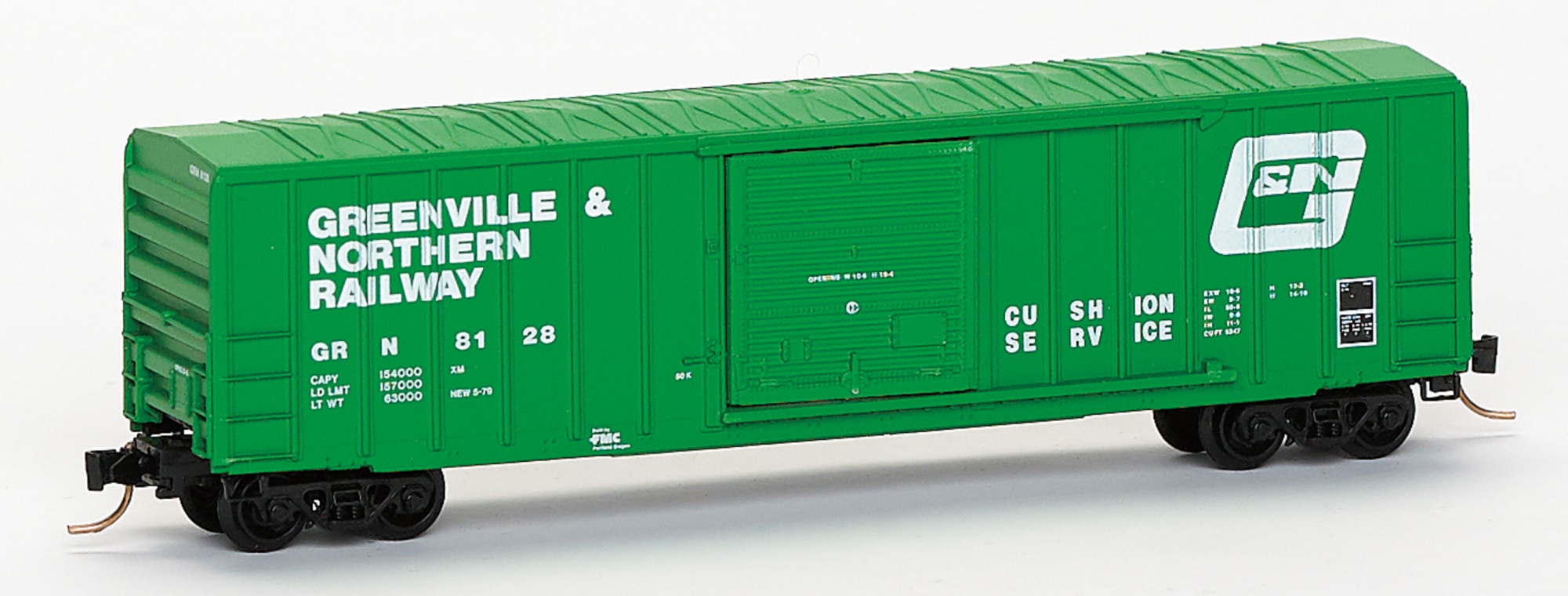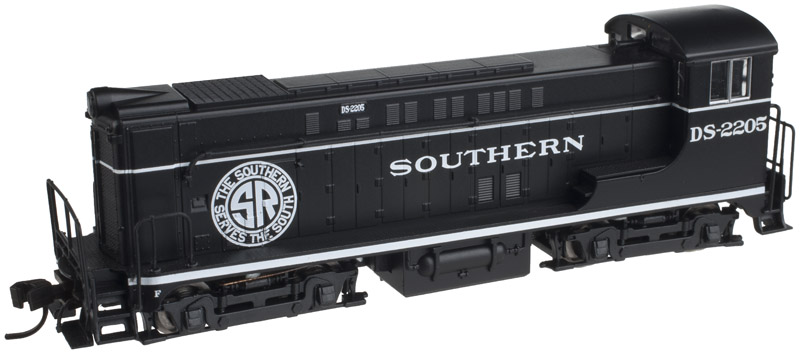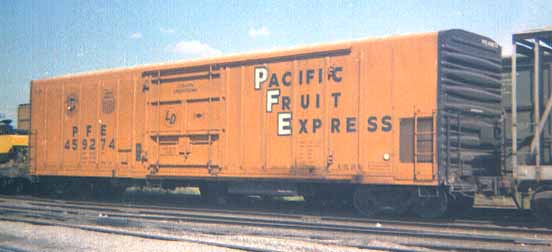Con-Cor - 1451O - Boxcar, 50 Foot, Steel - Apalachicola Northern - 5054
| Stock Number | 1451O |
| Secondary Stock Number | 0001-01451O |
| Original Retail Price | $1.75 |
| Brand | Con-Cor |
| Manufacturer | Kato |
| Body Style | Con-Cor Boxcar 50 Foot Panel Door |
| Prototype Vehicle | Boxcar, 50 Foot, Steel (Details) |
| Road or Company Name | Apalachicola Northern (Details) |
| Reporting Marks | AN |
| Road or Reporting Number | 5054 |
| Paint Color(s) | Yellow |
| Print Color(s) | Blue |
| Paint Scheme | Port Saint Joe Route |
| Coupler Type | Rapido Hook |
| Coupler Mount | Truck-Mount |
| Wheel Type | Nickel-Silver Plated Metal |
| Wheel Profile | Small Flange (Low Profile) |
| Release Date | 1976-01-01 |
| Item Category | Rolling Stock (Freight) |
| Model Type | Boxcar |
| Model Subtype | 50 Foot |
| Model Variety | Panel Door |
| Prototype Region | North America |
| Prototype Era | NA Era III: Transition (1939 - 1957) |
| Scale | 1/160 |
| Track Gauge | N standard |
Model Information:
This model was originally manufactured by Kato for Con-Cor. Manufacturing was later moved to Con-Cor's Chicago facility. The model sort-of resembles the PRR C41 prototype.
These models have issues, and I would advise most modelers and runners to stay away. First, they use a wonky clip-in truck that is not easy to swap out for MTL (or other knuckle-coupler equipped) trucks. For all of the samples of this model I have seen, the metal underframes, though nicely detailed, arrive out-of-the-box scuffed. The early Kato versions come with some very nice low-profile nickel-silver plated wheels, but the Con-Cor made version have some of the WORST wheelsets I have ever seen. They are plastic, low-profile jobs which have casting flaws that make them run horribly. Since you cannot swap the trucks easily, you simply cannot run this junk. Perhaps Con-Cor improved their wheelset quality in later runs, but the ones I looked at (VNOR 7739) are awful. Furthermore the Con-Cor releases have LOWER quality pad-printing than the earlier Kato releases. Unfortunately, the Kato releases used a high-gloss paint that looks terrible. So no matter which version you get, it will be disappointing.
These models have issues, and I would advise most modelers and runners to stay away. First, they use a wonky clip-in truck that is not easy to swap out for MTL (or other knuckle-coupler equipped) trucks. For all of the samples of this model I have seen, the metal underframes, though nicely detailed, arrive out-of-the-box scuffed. The early Kato versions come with some very nice low-profile nickel-silver plated wheels, but the Con-Cor made version have some of the WORST wheelsets I have ever seen. They are plastic, low-profile jobs which have casting flaws that make them run horribly. Since you cannot swap the trucks easily, you simply cannot run this junk. Perhaps Con-Cor improved their wheelset quality in later runs, but the ones I looked at (VNOR 7739) are awful. Furthermore the Con-Cor releases have LOWER quality pad-printing than the earlier Kato releases. Unfortunately, the Kato releases used a high-gloss paint that looks terrible. So no matter which version you get, it will be disappointing.
Prototype History:
While the 40-foot boxcar was a standard design, and it did come in different setups depending on the type of freight being transported, it was not large enough for efficient mass commodity transportation. The 50-foot boxcar made its first appearance in the 1930s and steadily grew in popularity over the years, which further improved redundancies by allowing for even more space within a given car. Today, the 50-footer remains the common boxcar size. After the second world war ended, and steel became once again readily available, steel became the go-to choice for construction of boxcars. Pullman Standard and ACF were some of the most prolific builders of these cars.
These cars came in many variations. For instance, double-doors became practical for large/wide loads, end-doors useful for very large lading such as automobiles, and interior tie-down equipment was helpful in keeping sensitive products from being damaged in-transit. In 1954 the Santa Fe developed its "Shock Control" (and later "Super Shock Control") technology for new boxcars with upgraded suspension systems to further improve the ride-quality and reduce the chance of damaging freight.
In the 1960s, the flush, "plug" style sliding door was introduced as an option that provides a larger door to ease loading and unloading of certain commodities. The tight-fitting doors are better insulated and allow a car's interior to be maintained at a more even temperature.
These cars came in many variations. For instance, double-doors became practical for large/wide loads, end-doors useful for very large lading such as automobiles, and interior tie-down equipment was helpful in keeping sensitive products from being damaged in-transit. In 1954 the Santa Fe developed its "Shock Control" (and later "Super Shock Control") technology for new boxcars with upgraded suspension systems to further improve the ride-quality and reduce the chance of damaging freight.
In the 1960s, the flush, "plug" style sliding door was introduced as an option that provides a larger door to ease loading and unloading of certain commodities. The tight-fitting doors are better insulated and allow a car's interior to be maintained at a more even temperature.
Road Name History:
 The Apalachicola Northern Railroad has been operating in the Florida Panhandle for more than 100 years running from the Gulf Coast to the Georgia border along a system that is nearly 100 miles in length. Today, The Port St. Joe Route is known as the AN Railway and owned by the Genesee & Wyoming. Amongst railfans the Apalachicola is perhaps best known for using a rare Electro-Motive road-switcher, all three of which are still in use on the property. In recent years it has struggled to survive after the loss of paper traffic, which made up a majority of its annual carloads for decades. However, to date it has persevered and still moves a fair amount of wood-related products. Additionally, the railroad has been able to find other sources of freight in recent years to diversify its traffic base, which will hopefully allow to carry on as a successful shortline for many years.
The Apalachicola Northern Railroad has been operating in the Florida Panhandle for more than 100 years running from the Gulf Coast to the Georgia border along a system that is nearly 100 miles in length. Today, The Port St. Joe Route is known as the AN Railway and owned by the Genesee & Wyoming. Amongst railfans the Apalachicola is perhaps best known for using a rare Electro-Motive road-switcher, all three of which are still in use on the property. In recent years it has struggled to survive after the loss of paper traffic, which made up a majority of its annual carloads for decades. However, to date it has persevered and still moves a fair amount of wood-related products. Additionally, the railroad has been able to find other sources of freight in recent years to diversify its traffic base, which will hopefully allow to carry on as a successful shortline for many years.
The history of the Apalachicola Northern Railroad begins on April 7, 1903 when it was chartered to construct a route north of Apalachicola to Chattahoochee where an interchange would be made with the Atlantic Coast Line as well as the Seaboard Air Line. After roughly two years construction on the line finally began on March 21, 1905 although it took two additional years until the route was finally opened, 76.5 miles. The road's owners were soon after looking to complete the line to Port St. Joe, just west of Apalachicola along the coast. However, it fell into bankruptcy in July of the same year it opened, 1907, due to construction costs and initial lack of traffic. A year later it had exited receivership in October of 1908 and by May 10, 1910 had finally completed its long sought extension, 19.8 miles, which earned it the name as The Port St. Joe Route and gave it a total system.

The history of the Apalachicola Northern Railroad begins on April 7, 1903 when it was chartered to construct a route north of Apalachicola to Chattahoochee where an interchange would be made with the Atlantic Coast Line as well as the Seaboard Air Line. After roughly two years construction on the line finally began on March 21, 1905 although it took two additional years until the route was finally opened, 76.5 miles. The road's owners were soon after looking to complete the line to Port St. Joe, just west of Apalachicola along the coast. However, it fell into bankruptcy in July of the same year it opened, 1907, due to construction costs and initial lack of traffic. A year later it had exited receivership in October of 1908 and by May 10, 1910 had finally completed its long sought extension, 19.8 miles, which earned it the name as The Port St. Joe Route and gave it a total system.
Brand/Importer Information:
Con-Cor has been in business since 1962. Many things have changed over time as originally they were a complete manufacturing operation in the USA and at one time had upwards of 45 employees. They not only designed the models,but they also built their own molds, did injection molding, painting, printing and packaging on their models.
Currently, most of their manufacturing has been moved overseas and now they import 90% of their products as totally finished goods, or in finished components. They only do some incidental manufacturing today within the USA.
Important Note: The Con-Cor product numbering can be very confusing. Please see here in the article how to properly enter Con-Cor stock numbers in the TroveStar database.
Currently, most of their manufacturing has been moved overseas and now they import 90% of their products as totally finished goods, or in finished components. They only do some incidental manufacturing today within the USA.
Important Note: The Con-Cor product numbering can be very confusing. Please see here in the article how to properly enter Con-Cor stock numbers in the TroveStar database.
Item created by: meadowsn1956
on 2019-09-19 00:34:05
Last edited by: CNW400 on 2020-07-08 10:30:17
If you see errors or missing data in this entry, please feel free to log in and edit it. Anyone with a Gmail account can log in instantly.
Last edited by: CNW400 on 2020-07-08 10:30:17
If you see errors or missing data in this entry, please feel free to log in and edit it. Anyone with a Gmail account can log in instantly.





